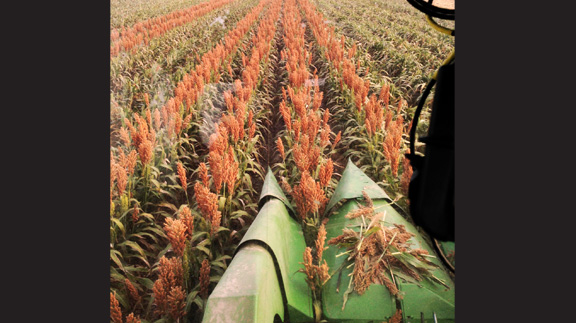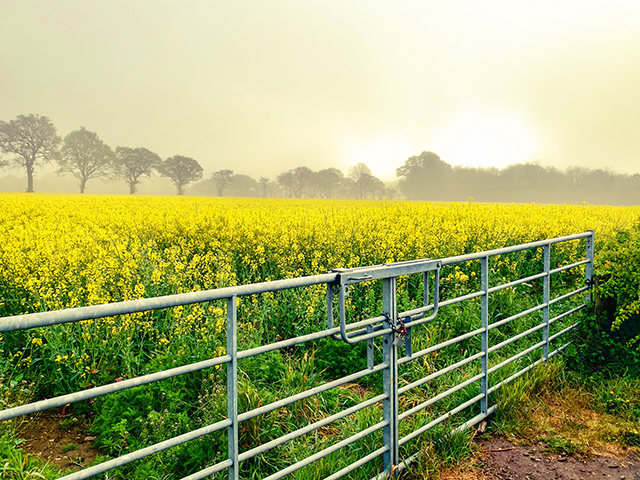Farm & Ranch
Weather forecasts could become seeding forecasts

By: Kay Ledbetter
Texas A&M AgriLife studies planting rates based on anticipated moisture
Writer: Kay Ledbetter, 806-677-5608, [email protected]
Contact: Dr. Ronnie Schnell, 979-845-2935, [email protected]
COLLEGE STATION – A Texas A&M AgriLife Extension Servicestate cropping system specialist hopes producers can use the weather forecast for not only deciding how to dress, but to alter management practices based on expected conditions.
The research project, “Optimizing Grain Sorghum Seeding Rates for Anticipated Hydrologic Conditions,” is led by Dr. Ronnie Schnell, AgriLife Extension specialist in the Texas A&M University soil and crop sciences department.
Joining Schnell in the research are Ryan Collet, AgriLife Extension agent in Hill County; Dr. Tony Provin, AgriLife Extension soil chemist, College Station; Russell Sutton, Texas A&M AgriLife Research associate research scientist, Commerce; and Jon Gersbach, AgriLife Extension agent for Milam County. This work was supported by the Texas Sorghum Producers.
“What we are trying to do with this project is determine: If we have an idea what the weather is going to be and the seasonal rainfall outlook, can we alter our management practices based on those long range forecasts?” Schnell said.
If the forecast can be utilized, he said, this could give producers an opportunity to reduce seeding rates significantly if drier than normal conditions are expected, as well as other yield-based inputs such as nitrogen to match anticipated moisture conditions.
“Excessive plant populations can exacerbate soil moisture limitations and result in lower yields, stalk rot diseases and lodging in grain sorghum,” Schnell said.
He said finding the optimum seeding rate is complicated by the variability of pre-season soil moisture and in-season precipitation.
In its first year, this study evaluated grain sorghum yield in response to increasing seeding rates and contrasting soil moisture conditions in the central and northern Blacklands of Texas.
The trials were imposed at five locations in the central and northern Blacklands. April and May precipitation was slightly below normal, while June precipitation was well above normal. Over the three months, precipitation was in line with foretasted conditions. Winter precipitation, although variable, had been sufficient to recharge the soil profile before planting.
“We looked at seeding rates and we wanted to know if we could identify optimum population rates for given hydrological conditions and then if we could use some of the long-term forecast to adjust our seeding rates,” Schnell said.
This year at planting time, precipitation was not expected to be above or below normal, so no adjustment to normal seeding rates would be justified.
“But, what we did see in June as the crop reached critical growth stages and water use started to peak was depletion of profile soil moisture,” he said. “This year we also had above-normal precipitation in June, so we had the water to replenish that profile. But we know the soil moisture was rapidly depleted during later growth stages, possibly resulting in brief periods of moisture stress at all locations.”
Without timely rainfall, moisture stress would have intensified and higher plant populations may not have been successful, Schnell said.
He said in this first year of testing, the optimum population rate for the sites was near what the normal recommendation would be because of the predicted moisture.
“We have to keep in mind that for this year we had a full profileat planting and had some very timely heavy rainfalls during the growth stages, so this year will represent a year where higher seeding rates would be successful,” Schnell said.
“However, there are other years that we suspect if we did not get normal rainfall, it would certainly justify reductions to those seeding rates and that would help to maintain and reduce some of the secondary issues you come up with when moisture is limited.”
Schnell said they will try to continue the study at some level next year and have a broader range of moisture-level conditions to compare.
-30-
Farm & Ranch
Meanwhile, Back at the Ranch…

By Rayford Pullen | [email protected]
When May arrives, we start thinking about weed control. With two years of drought under our belts, grass grazed short and hay stocks depleted, what we do now will influence our forage conditions for the entire year. With 75 percent of our annual warm season forages made by July 15 in North Texas, we need to get the grass growing while the sun shines.
Speaking of the sun shining, the biggest deterrent to growing lots of grass is restricted sunlight, and the biggest sun blockers we have are weeds.
Have you noticed weeds are normally just slightly taller than your grass and are probably blocking 90 percent of the sunlight from reaching the grass itself? So obviously, we need to improve conditions, so sunlight reaches the plants we want to grow.
With grass extremely short, more sunlight is hitting the soil surface now, which in turn results in more weed seed germinating. With the moisture we have received, we expect an abundance of weeds this year.
To read more, pick up a copy of the May issue of NTFR magazine. To subscribe by mail, call 940-872-5922.
Farm & Ranch
Land Market Report: March Land Sales

By Jared Groce
Rural land sales are continuing on a steady pace for early spring, with prices holding very strong with the sell-to-list price ratios remaining very high, even on properties that have been on the market for a longer than usual time period. The total number of transactions are picking up once again as the spring selling season kicks off, and the average acreage continues to decrease.
Larger acreage properties seem to be in higher demand than smaller properties currently, with many buyers simply parking cash in real estate to hedge against inflation. Interest rates seem to have settled down and most experts agree that rates will be reduced by the fed this year. Some lenders have programs in place that allow the buyer to reduce their rates without having to go through a full refinance ordeal.
To read more, pick up a copy of the May issue of NTFR magazine. To subscribe by mail, call 940-872-5922.
Farm & Ranch
Texas FFA State Vice President Weston Parr

Future Farmers of America was founded by a group of farmers in 1928 with the mission of preparing the next generation of agriculture. It has done just that during its 95-year history, as the organization works to give back to others by following its motto, “learning to do, doing to learn, earning to live, living to serve.”
FFA is an organization made up of state associations, and at the helm of the Texas FFA is a team of 12 officers representing their respective areas within the Lone Star State. These individuals dedicate a year of their lives as they serve members, provide leadership, and work together with the state staff and board of directors to develop policy and lead the organization of over 177,000 members.
North Texas is represented by Area IV and Area IV, stretching from Wilbarger County to Bell County and from Runnels County to Grayson County. This year, those chosen to lead this great area are State President Isaac Hawkins Jr., Area IV, and State Vice President Weston Parr, Area V.
Parr is from the Sam Rayburn FFA chapter and the Area V Association, but the leader who now serves more than 19,100 members of Area V entered the FFA organization as a shy teenager who sat in the back of the room.
“I didn’t talk to a whole lot of people. I didn’t know what I wanted to do with my life or where I could see myself, so I wasn’t involved on my high school campus,” Parr recalled.
“Then I started FFA and slowly but surely, my ag teachers worked me into attending more contests, meeting new people, and speaking. I remember the first time I gave an officer speech to my chapter. I can still remember how embarrassing it was. To see the progression from that moment to speaking on stage at the state convention in front of thousands of people. Now I feel like I can enter the industry I want and be successful all because of what FFA afforded me for five years.”
There is not much Parr did not do during his time in high school. His contest participation included chapter conducting, wool judging, cotton judging, wildlife, and job interview, but his favorite was extemporaneous speaking, which he did not start until his senior year of high school.
“I wish I could go back to my freshman, sophomore, and junior years and start that sooner. I think if I had more time, I would have been more successful than I already was, but that was something I didn’t realize I liked at the time. I’m not naturally somebody who likes to speak in public, but it was actually my favorite,” Parr said.
Parr won several awards during his time competing. In 2023 alone, Parr earned the Texas FFA Service-Learning Proficiency title, was a National FFA Service-Learning Proficiency finalist, and a Texas FFA Extemporaneous Speaking finalist. In addition to his CDE and LDE events during high school, he showed commercial steers at Houston, and boilers at most major shows, participated in the county show with projects in ag mechanics, showed goats from time to time, and showed heifers until graduation.
“FFA provides invaluable resources and knowledge to be successful once you leave high school and you are out of the blue jacket for the first time. I have been a part of a lot of great organizations over the years, and they are all great in their own way, but in my opinion, FFA is the most successful at producing members of society who want to go and do something with themselves,” Parr said.
He was halfway through his time as Area V Association President and attending the national convention when he began to ponder the idea of running for state office.
“This is around the time when you usually figure out if you want to go through and be a state officer or you decide that area officer is your last run. I was unsure of where I wanted to go, but I knew I didn’t want to be done with FFA. I decided maybe it would be a good opportunity not only for me to make more friendships and connections, but also to give back to the program that allowed me to be able to do what I can do today,” Parr explained.
To read more, pick up a copy of the May issue of NTFR magazine. To subscribe by mail, call 940-872-5922.
-

 Country Lifestyles1 year ago
Country Lifestyles1 year agoScott & Stacey Schumacher: A Growth Mindset
-

 Equine8 months ago
Equine8 months agoThe Will to Win
-

 Country Lifestyles7 years ago
Country Lifestyles7 years agoStyle Your Profile – What your style cowboy hat says about you and new trends in 2017
-

 Country Lifestyles4 years ago
Country Lifestyles4 years agoAmber Crawford, Breakaway Roper
-

 HOME7 years ago
HOME7 years agoGrazing North Texas – Wilman Lovegrass
-

 Country Lifestyles7 years ago
Country Lifestyles7 years agoDecember 2016 Profile, Rusty Riddle – The Riddle Way
-

 Outdoor9 years ago
Outdoor9 years agoButtercup or Primrose?
-

 Country Lifestyles8 years ago
Country Lifestyles8 years agoJune 2016 Profile – The man behind the mic: Bob Tallman






